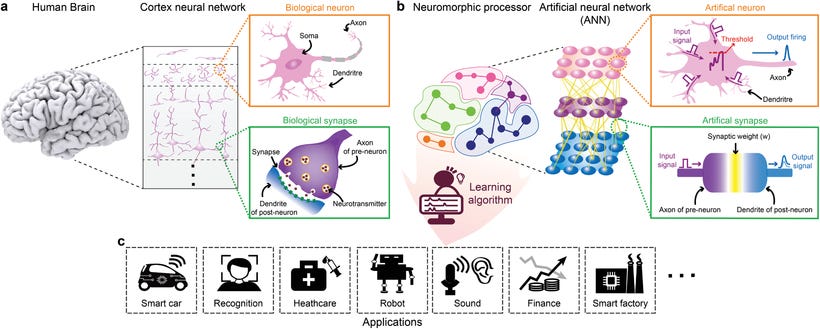Neuromorphic Network
The 'Artificial Brain' as a replacement for smartphones
Dj Sengal feat Diana Barash – 1000 Years
We need to understand that the technology market has made a significant leap in smart phones since the appearance of the blackberry to the present day: access to the web has expanded globally, the interconnectivity of interpersonal and intrapersonal human relationships has changed with the emergence of social bubbles fom apps such as Metta, TikTok, LinkedIn, etc., with smart phones being considered an extension of the mind.
Therefore, the development of technology is at an interesting stage with the probability of emerging a new method of making inference with the web window or of evolving the synapses between human-machine-internet with the possibility of the emergence of enhancing the cerebral cortex that currently infers in the digital universe: five sense consciousnesses, of which we only use two (visual cortex and auditory cortex) in a normal inference with the web, and in extraordinary cases we use three – video games that allow the touch consciousness to emulate reality.

Let's for a moment imagine that neuromorphic engineering takes a significant quantum leap in the use of large-scale integration systems that contain analog electronic circuits to imitate the neurobiological architectures present in the brain and central nervous system. The terminology is used to describe large-scale integration systems analog, digital, mixed analog/digital mode systems and neural systems with processing through highly sophisticated algorithms capable of synapsing with the totality of sense consciousness in an interdisciplinary interface grounded in neuroscience, biology, physics, mathematics, computer science and electrical engineering. The aim is the design of artificial neural systems whose physical architecture and design principles are based on biological neuronal architecture.
In creating a neuromorphic network formed by the random self-assembly of silver nanowires coated with a polymer layer after synthesis in which the junctions between two nanowires act as resistive switches, generally compared to neurosynapses – using this network, scientists generate electrical characteristics specific functions similar to those associated with higher order brain functions exclusive to human beings such as memorization, learning, forgetting, alertness and return to calm, in an inference with the digital universe with a new technological item that is highly subtle, easy to manage and capable of making synapses simultaneously with a mind-internet interface.

The most important of the entire structure are the considerations related to ethics: although the interdisciplinary concept of neuromorphic engineering is recent, many of the ethical considerations apply to neuromorphic systems that apply to "human machines" (if we equate robotics, vehicles autonomous, etc.) and A.I. in general, as they are designed to imitate the human brain, which generates unique ethical questions surrounding the use of these artificial neural networks.
The intelligent assistant 'Alexa' will be evolving into an 'Artificial Brain' with quantum processing in a significant number of qbits that allows analytical-intuitive-creative thinking within a golden wristwatch with the ability to project the layout or work environment of the operating system in a hologram that we can interact with the consciousness of touch in the interference of specific light frequencies capable of creating the three-dimensional "illusion"?

The idea here is to create a project that is a subsidiary of a large technology company with capital capable of supporting the design development of an 'artificial brain' with an implementation that could be based on the principles of coherence/incoherence nonlinear phase of Holographic neural technology. In an analogy to quantum processes through the nuclear synaptic algorithm, which in turn has great similarity with the wave equation of quantum mechanics.
Since 2008, IBM has received around $4.9 million from the Pentagon to conduct research into the production of intelligent computers: the Blue Brain project consists of the premise of the possibility of synapsing with an interface through thirty million neurons in their three-dimensional positions. The progress of the Blue Brain project is much ahead of what was previously estimated: "consciousness is just a huge amount of information being transmitted by trillions of neurons" – can reformulate the progress estimate and equate the probability of inputs for downloading the information contained in a human brain to a physical digital platform or to a 'cloud' for restricted access until 2050.

There are good reasons to believe that predictions of the production of 'Artificial Brains' in the near future are optimistic. But not everything is rosy, there are some obstacles – brains in particular (including the human brain) and cognition are not yet well understood, and the scale of the computation required needs adjustment. Energy limitations in the design are engineering obstacles: the human brain consumes around 20W of energy in 24 hours, on the other hand a supercomputer can consume in the order of 1MW (note: the Landauer limit is 3.5x1020 op/sec/watt at temperature environment) which makes component design an increasingly meticulous process.

